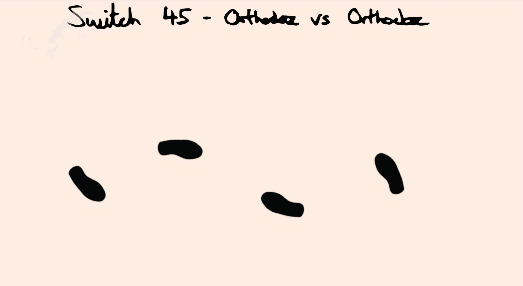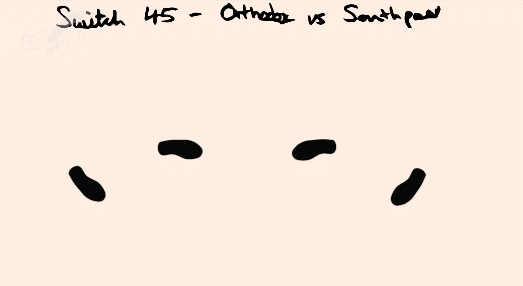Calvin Kattar and the
Switch 45
Naturally a lot of the mixed martial arts talk in the last week has focused Francis Ngannou’s successful title defence against Ciryl Gane, and his deteriorating relationship with the UFC. But a week earlier, on a rather understated Fight Night card, Calvin Kattar put Giga Chikadze through the ringer in a comeback performance just short of Lazarus’. In the course of that performance Kattar demonstrated not only toughness and craft, but an awareness of just what made his opponent dangerous, and just how to take that away.
Chikadze is a powerful kicker. More than that, he has an eye for an opening. If the opening doesn’t present itself organically, he will go out and make it appear. Chikadze’s fight ending sequence against Cub Swanson is a perfect example: Chikadze will initiate an attack out of an orthodox stance, then retreat to a southpaw stance. The moment that his opponent moves in to close the distance, Chikadze hammers home the left kick to their liver. This retreat-to-southpaw tactic has remained part of his game from since his kickboxing career and could be seen from his very first UFC bout against Brandon Davis. It encourages an opponent to advance onto Chikadze at the exact moment that his most dangerous weapon becomes a possibility.
The retreat to southpaw becomes a matter of increasing concern when you want to operate the standard anti-kicker strategy of keeping the kicker on the back foot. Constantly advancing does not mean that you are always open for the liver kick, but in the course of a twenty-five minute fight with an opponent who switches stances regularly, it is easy to lose track and eventually run onto a fight changing blow.
The Basic Switch 45
From the beginning seconds of the Kattar – Chikadze fight until the bout’s conclusion, Calvin Kattar made use of a technique which in point fighting is called the “Switch 45”. To perform a switch 45 from an orthodox stance, the fighter steps out to his left with his left foot, squaring his stance. The fighter than stabs his right foot in, advancing into a southpaw position from slightly off to the side.
Fig. 1
The angle is seldom the forty-five degrees the name suggests, but if there is one theme across all martial arts it is misleading nomenclature. Ultimately the purpose is to side step and then cut in from a slight angle, and as with all angling: the quicker the opponent reacts, the less severe that angle is going to be. And of course, the angle is not something to be taken and held—it is a momentary advantage won and a good chance at a free attack as the opponent pivots to face.
In point fighting the switch 45 is often used from a closed stance position. Hidden in amongst other side steps and constant bouncing, the idea is to get to the opposite stance and shoot a linear attack—a quick one-two most likely—up the opponent’s centreline. A good rule for chasing the centreline is to try and get to where the opponent’s belly button or solar plexus is pointing.
To see an example of this chase-the-centreline principle in an MMA context look to T.J. Dillashaw. In his second fight against Renan Barao, Dillashaw used a wave of his right hand and a darting movement out to his left in order to square out his stance, and then come back in on the angle as a southpaw, popping Barao with a jab or one-two.
Fig. 2
Of course things get a little wavy around the boundaries. The switch 45—particularly from a closed stance position—is quite similar to the Pep Step. Willie Pep circled out to his left, leveling his feet, and as the opponent pursued him he would step back in to meet them in a southpaw stance.
The Pep step and the switch 45 are applications of the same fundamental principle of switch hitting: using lateral movement to change stances. But where the Pep step is about behaving evasively and drawing the opponent onto you, the Switch 45 is a quick direction change into advance. The Pep step is also a technique that thrived within Pep’s lateral movement driven style: Pep ran laps of the ring through each fight. The switch 45 has its roots in point fighting, where competitors are often fencing on a line in longer, more bladed stances, not much concerned with lateral movement or able to apply it as readily. The switch 45 from a closed stance position is also marked out by curving second step to cut inside the opponent’s lead foot.
Fig. 3
With that being said, the switch 45 is normally applied as a quick switch up into a blitz. Calvin Kattar was not looking to sneak to the inside of Kattar’s lead foot and shoot straight blows up his centreline: Kattar’s intention in using the switch 45 for the most part was to deny Giga Chikadze his southpaw left body kick. Every time Kattar began advancing, Chikadze would retreat back into southpaw to try and time Kattar with the kick as he came in. Each time Chikadze switched to southpaw as Kattar was walking him down, Kattar would step out to his left and come back in southpaw.
Fig. 4
Figure 5 shows Kattar performing this preventative switch 45 against Chikadze. Kattar takes a step out to his left, taking him away from the left round kick (b) before cutting back in with a curving step (c). Notice that in frame (c), Chikadze’s left kick is now no longer lined up with Kattar’s open side and is instead going into Kattar’s back—a far less threatening connection. Or to look at it another way, Kattar’s nifty shift was a clever way to turn his belly button away from the kick while always advancing.
Fig. 5
The importance of the lateral step was seen in the early rounds when Chikadze was still kicking actively. Figure 6 shows how a left step takes Kattar off the line of the kick in a timely fashion and, as was his way through the entire fight, he curve steps back into southpaw to keep up the pursuit.
Fig. 6
The obvious value of the switch 45 was that it took away one specific weapon when the stances matched up that way. But if that were the only purpose, Kattar would have only needed to do it from orthodox to southpaw and yet throughout the fight Kattar switched and switched again as Chikadze attempted to get onto an open stance footing. All the while advancing, and all the while boxing Chikadze on the snoot with jabs from both hands and both stances, and then uncorking elbows and uppercuts when Chikadze ran himself onto the fence.
Fig. 7
While the switch 45 itself had a great showing in this fight, the overall effect of the bout was to confirm our golden rule about effective switch hitters. The best switch hitters understand their openings off each stance and the dynamic between open and closed stance positions, but in ninety percent of their outings they will be the only man willing to switch. The moment that both men are switching stances, the openings become a lot trickier to manufacture and pick up on in time and the bout takes on a more frantic and chaotic nature. Against a low output striker like Chikadze, those openings disappearing as fast as he could get a look at them was as good as cutting off his left leg altogether.







